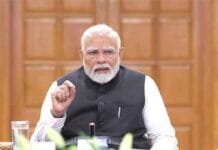April 5, 2025 | New Delhi
As the global trade war enters a fresh phase, mobile tech giants like Apple, Samsung, and Motorola are quietly warning India: cut export duties, or risk losing the next $100 billion in mobile manufacturing investments.
India, once touted as the world’s next iPhone factory, may now face a major setback. The 27% retaliatory US duty on imported smartphones has rattled boardrooms from Cupertino to Gurugram — and now, top global brands are exploring a “Plan B”: Brazil, the UAE, Singapore, even Saudi Arabia.
“Even after recent reductions, India’s import duty on components still adds 6–8% to the total bill of materials,” said a senior official at a global mobile device maker. “That’s 2–3% on export volumes alone. For high-volume players like Apple, this could kill competitiveness.”
The Tariff Domino Effect
While India currently enjoys better tariff terms than China (54% US import duty) and Vietnam (46%), the race is far from over. Vietnam’s government has already launched a diplomatic offensive, with Deputy Prime Minister Ho Duc Phuc preparing to fly to Washington to negotiate relief.
Meanwhile, India’s mobile exporters find themselves stuck between rising US tariffs and India’s own tax maze.
“We’ve built an assembly ecosystem here for over a decade,” says an EMS (Electronics Manufacturing Services) executive. “But if Brazil gives a 7–8% cost edge on exports to the US, the boardrooms will ask hard questions.”
Battle of the New Tech Hubs
According to industry insiders, countries like Brazil, Saudi Arabia, UAE, and Singapore are now aggressively courting mobile giants with offers India cannot ignore:
Zero-tax regimes or flat, simplified taxes
Massive SEZs with ready-to-use infrastructure
Fast-track clearances and dollar-denominated incentives
Brazil, despite higher labor and logistics costs, is still managing to offer a 7-8% export edge to the US due to friendlier trade terms.
“It’s ironic,” a US-based executive said. “India has the scale and manpower, but the policy pressure might make us go where the math works better.”
📉 Could India Lose the $300B Mobile Dream?
According to Canalys, over 60% of US smartphone imports come from Apple, followed by Samsung (21%), Motorola (10%), and TCL and Google (3% each). A shift in just one major brand’s export strategy could shake up India’s status as a global mobile hub.
India’s Production Linked Incentive (PLI) schemes have helped anchor companies like Foxconn, Wistron, and Pegatron. But global competition is heating up — and India’s complex tax structure is now becoming a potential deal-breaker.
📣 The Industry’s Message to New Delhi: Act Now or Regret Later
Global tech giants are now lobbying New Delhi for deeper export-linked incentives — or at least a waiver on duties that affect outbound shipments.
“We’re not asking for the moon,” said one senior policymaker off the record. “But if India wants to win the global supply chain game, it must play to win — and act before others do.”
As global geopolitics redraw the map of trade and manufacturing, one thing is clear: India’s next big export is not just smartphones — it’s policy clarity.
🔍 Follow this story for updates on US-India trade talks, global supply chain shifts, and India’s electronics manufacturing revolution.















